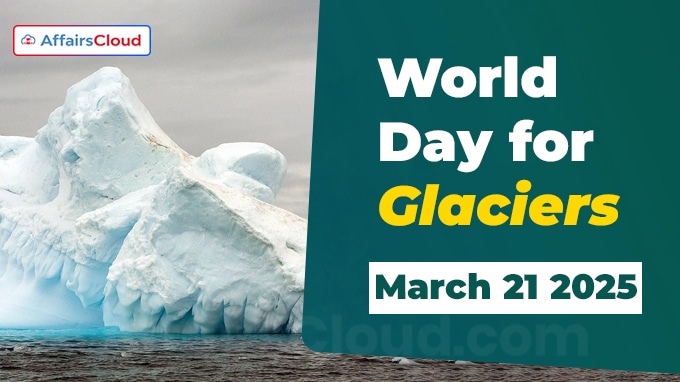
The first World Glacier Day was celebrated on March 21,2025, and it will be observed annually on the same date to raise awareness about glacier protection. It was established by the United Nations (UN) to highlight the immediate need to protect glaciers and address climate change. This day highlights the critical role glaciers play in sustaining ecosystems, freshwater supplies, and global climate stability.
- According to reports “State of the Global Climate 2024”, published by the World Meteorological Organization (WMO) with the support of the World Glacier Monitoring Service (WGMS), the years 2022 to 2024 saw the biggest loss of glacier ice ever recorded over a three-year period. During this time, all 19 glacier regions around the world lost ice.
Background
- The United Nations General Assembly (UNGA), through its resolution A/RES/77/158 in 2022, has declared March 21 as the World Day for Glaciers.
- The UNGA proclaimed 2025 as the International Year of Glaciers’ Preservation, aimed at raising global awareness about the alarming retreat of glaciers due to climate change. The observance is supported by UNESCO, the World Meteorological Organization (WMO), and the Government of Tajikistan.
World Glacier Day & International Year of Glaciers 2025
- Objective: Raise awareness, promote research, and drive policy changes to limit global warming to 1.5°C (Paris Agreement).
- UNESCO’s Role: At its 2023 Paris summit, UNESCO urged nations to cut emissions by 45% by 2030 and fund glacier monitoring systems.
Threats to Glaciers
Glaciers store 69% of Earth’s freshwater, feeding major rivers like the Ganges and Indus, which support over 1.9 billion people.
- Rising temperatures due to greenhouse gas emissions are the primary cause of glacial melt.
- Record Retreat: UNESCO’s 2023 report states glaciers in World Heritage sites, like Kilimanjaro and Yellowstone, could vanish by 2050 if emissions remain unchecked.
Joint Celebration of World Day for Glaciers and World Water Day 2025
As part of the International Year of Glaciers’ Preservation 2025, a joint celebration of the first World Day for Glaciers and World Water Day was organized to address the urgent challenges posed by accelerating glacier melt and its impact on water security, communities, and ecosystems. This high-level event took place on March 21, 2025, at the United Nations Headquarters in New York.
- Launch of the 2025 World Water Development Report: “Mountains and Glaciers: Water Towers”.
- During this event, the 2025 United Nations World Water Development Report, titled “Mountains and Glaciers: Water Towers,” was officially launched.
- This report emphasizes the critical role of mountain waters, including alpine glaciers, in sustaining water supplies and maintaining ecosystem stability.
“State of the Global Climate 2024” -WMO
The “State of the Global Climate 2024” report was prepared and released by the World Meteorological Organization (WMO).
- It is WMO’s flagship annual report, providing authoritative information on global climate trends and their impacts.
- The 2024 edition highlighted the largest glacier mass loss ever recorded over a three-year period (2022–2024), with all 19 glacier regions worldwide experiencing ice loss.
2024 hydrological year
The 2024 hydrological year marked the third year in a row in which all 19 glacier regions experienced a net mass loss.
- Glacier mass loss was 450 billion tons in the 2024 hydrological year – the fourth most negative year on record.
- While the mass loss was relatively moderate in regions like the Canadian Arctic or the Greenland periphery, the glaciers in Scandinavia, Svalbard, and North Asia experienced their largest annual mass loss on record.
Glacier of the Year 2025: South Cascade Glacier
On the first World Day for Glaciers, the WGMS presented the first “Glacier of the Year”. In 2025, the South Cascade Glacier, located in the Cascade Range, Washington, United States of America (USA) was named Glacier of the Year.
- It has been monitored continuously since 1952, making it one of the longest-studied glaciers in the Western Hemisphere.
- The glacier provides valuable data on mass balance and helps scientists understand the effects of climate change.
About World Meteorological Organization (WMO):
Secretary-General – Prof. Celeste Saulo
Headquarters -Geneva, Switzerland
Established – 1950
UNSpecialized Agency Since – 1951




